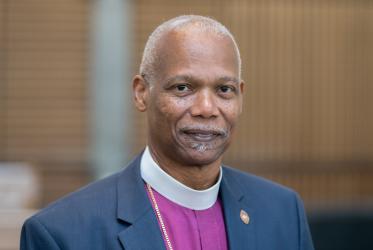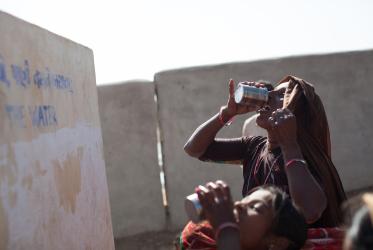For the Evangelical Lutheran Church of Geneva’s English-speaking Congregation (ELCG-ESC), Lent became a season to engage in the Ecumenical Water Network’s emphases on water, or the lack thereof, through their Lenten campaign of Seven Weeks for Water. The worship planning team examined the Revised Common Lectionary (RCL) texts to explore where water imagery might be found and brought to symbolic, liturgical expression in Sunday worship. The texts ranged from the arid wilderness of temptation to the living waters offered to a Samaritan woman to Jesus’ tears at Lazarus’ tomb to an upper room foot-washing to the watery Easter Vigil texts of creation, flood, Exodus and Isaiah’s invitation to everyone who thirsts to come to the waters. The worship planning team centred on the Biblical image of a bucket from John 4:11 where the Samaritan woman observes that Jesus has no bucket – within worship, the image became at times an empty bucket of hope and at other times a bucket spilling over with living water.
Liturgical music, and hymns from the nations prayed for within the WCC Ecumenical Prayer Cycle, accompanied our worship week by week.
Links to each of the full texts of the liturgies are provided. Segments from each of these Lenten liturgies as well as the sermon can be seen via video on the ELCG-ESC website.
Ash Wednesday + 5 March 2014
Lent begins with the dry ashes of mortality on Ash Wednesday. For the confession in this liturgy, symbols of environmental devastation and pollution were presented – empty plastic water bottles, cigarettes, a cell phone. During the confessional litany, the plastic bottles were rhythmically hammered against one’s hand. As the confession moved from the corporate to the personal, the bottles were scrunched underfoot as if to join our confession with the cry and lament of all creation.
Into this dry, ashen wasteland a young man came carrying an empty bucket, looking for signs of hope. He kicked aside plastic bottles and stepped on cigarettes as a confessional litany, which joined Psalm 51 with Isaiah 58, was prayed. As the confession concluded, the young man approached the altar and with ashes made the sign of the cross on thepresiding minister’s forehead and whispered, “Remember that you are dust and to dust you shall return.”
The presider then did the same to the worshippers. In the sermon, the assembly was reminded that the cross of ashes on their brow was smudged in the same place where a cross that been traced at their baptism with the words, “[Name], child of God, you have been sealed by the Holy Spirit and marked with the cross of Christ forever.” The watery promise of baptismal death and resurrection got there first.
For the offering, small empty buckets were used to receive the monetary offerings. Throughout the season of Lent these small buckets were used for the offering, and printed in the worship bulletin was information about a Lutheran World Federation project to provide relief from the multi-year drought being experienced in Namibia and Angola.
First Sunday in Lent + 9 March 2014
On the First Sunday in Lent, the texts bring to remembrance the report that Jesus walked wet from baptism into the dry, barren wilderness to be tempted. So on this Sunday a call to prayer with biblical imagery and contemporary crises reminded the assembly that they too are tempted.
Second Sunday in Lent + 16 March 2014
The Second Sunday in Lent recalled the story of Jesus meeting Nicodemus by night to engage in a dialogue about being born again. Nicodemus’ repeated question, “Rabbi, how can these things be?”, structured the call to prayer as well as the creed for this day.
Third Sunday in Lent + 23 March 2014
We began our worship in the archaeological site beneath Geneva’s 12th-century Cathedral St Pierre where there are the remains of three predecessor churches dating to the 5th century. In the site is the oldest octagonal baptismal font found north of the Alps. There we began our worship beside the dry, dusty ruins of a 5th century baptistery by remembering the spring of living water into which we had been baptized. There the assembly renounced evil and affirmed their faith in the Triune God.
We then moved outside and processed through the streets of Geneva’s Old Town. The text for this Sunday was the story of Jesus and the Samaritan woman at the well. During our procession we stopped at three fountains to hear the gospel reading. Four women carrying buckets of water who were in the procession poured water from their buckets into the hands of the worshippers to give them a taste of living water.
Then the procession continued to the 15th-century Madeleine Church for the sermon and eucharist.
Fourth Sunday in Lent + 30 March 2014
A young graduate student enacted the man born blind who is healed when Jesus spits into the dust to make an ointment for the man’s eyes and then tells him to go and wash at the pool of Siloam.
The “blind man” entered as the liturgy began. He startled some of the visitors who believed he was indeed a blind man looking for a place in the worship space. He sat down beside the altar and then later stood up as the gospel reading unfolded.
Within this liturgy four baptisms were celebrated: a woman and her 5-year old twin daughter and son, along with a 6-week-old South African infant. The adult woman gave a testimony similar to that of the man born blind, describing how she had not seen the importance of Christianity for decades until now.
Fifth Sunday in Lent + 6 April 2014
This Sunday the lectionary twinned the story of Ezekiel’s vision of the valley of dry bones with the gospel story of Jesus raising Lazarus to new life. Where might water imagery be found in these two texts of dry bones and death? In Jesus’ tears. Tears provided the imagery for this worship – as the gospel text guided the assembly toward prayers for healing, prayers of lamentation and prayers of resurrection hope. At a couple of points in the service the pastor took cloths and symbolically wrung wet tears from the cloths into a bucket.
Then at the culmination of the gospel reading, when Jesus calls Lazarus back to life from the tomb, the ancient text from Ezekiel was woven into the narrative. It was as if Ezekiel’s invocation of the Spirit from the four winds called the dry bones back into life even as Jesus called Lazarus forth to new life. This interwoven text was accompanied by a growing sound of rhythmically marching feet – first one, then a few, then several and then many, many feet swelled the sound of life risen in Christ.
With the links to the liturgies, note how each week within the Eucharistic Prayer the biblical water-salvation imagery flowed through the prayer while also naming different rivers of the world.
What comes next? Some thoughts and questions for reflection:
Holy Week 2014
Now, let your imagination and faith-full creativity join the journey! With the watery imagery of this Lenten journey in mind, now it becomes your turn:
- What water symbols and images (or the absence thereof) come to your mind as you reflect on the familiar texts of Holy Week?
Palm Sunday + Sunday of the Passion
This year the Passion narrative according to St. Matthew will be read.
-
Where do you see water images in those texts?
-
Is the image of water seen in Peter’s bitter tears after his denial? Only Matthew’s gospel portrays Pilate taking water and washing his hands.
-
How would you bring to liturgical expression the water with which Pilate seeks to wash his hands from any guilt?
Maundy Thursday
On Maundy Thursday, foot-washing is a watery image of servanthood and the commandment to love. John reports that it is the festival of the Passover (John 13:1), so what is in the background: tears of grief over the death of the first born? waters of the Red Sea yielding before the liberation of Hebrew slaves? the death by drowning of Egyptian troops?
Good Friday
On Good Friday, the Passion according to St. John is proclaimed. Jesus on the cross whispers, “I thirst.” Is this the image for the day that takes the community into solidarity with those who thirst today for clean water, rather than contaminated water; who thirst for available water rather than a several-hour journey to a stream or faucet?
Then a few verses later at John 19:34, a soldier’s spear proves the death of Jesus as water and blood flow from his side. To this day many churches direct that water be added to the chalice at the eucharist in remembrance of this mingled imagery of life administered with the blood of Christ in the cup of salvation.
The Easter Vigil
The Easter Vigil is the liturgy of the Church Year. This was the time when the ancient church washed people into Jesus’ death and resurrection at baptism. The four-part liturgy begins with the blessing of a new fire and lighting of a Paschal Candle. It then proceeds into the liturgy of readings where biblical stories of salvation using water are heard: the waters of creation, Noah’s ark upon the flood, Hebrew slaves walking through the Red Sea on dry land before waters wash over the Egyptian soldiers and Isaiah’s invitation: “Ho, everyone who thirsts, come to the waters....” (Isaiah 55:1)
Biblical imagery of salvation in the form of waters spills over into the baptismal font – the third part of this liturgy – as new children of God are washed in the grace-full waters of baptism. In the fourth part, all are fed at the Table of the Lord with the bread of life and cup of salvation in the first eucharist of Easter. Then they are sent back out into the world to share the living water of the Risen Christ: “Go in peace. Serve the Lord.”
* Rev. Dr Stephen M. Larson has been the pastor of the Evangelical Lutheran Church of Geneva, English speaking Congregation from 1988 to 2003, and its interim pastor from 2012 to 2014.




